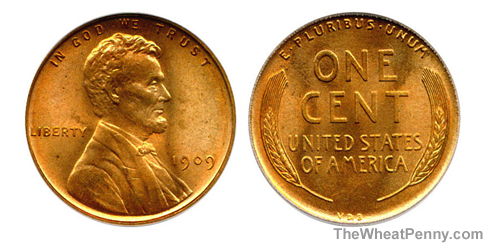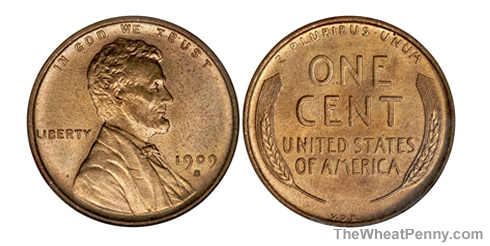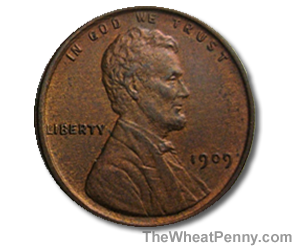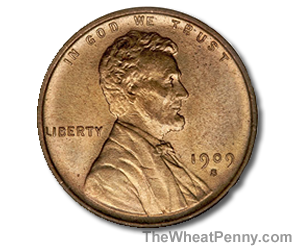About The Wheat Penny
The Million Dollar Penny: Bob Simpson’s History of Coin Collection
Prior to being known as the co-chairman of the Texas Rangers Major League Baseball team, Bob Simpson of Fort Worth Texas had already begun to earn his status as a legendary coin collector. Though he has only seriously been in the coin collecting arena for about the last 10 or so years, Simpson started his great love of coins when he was merely a youngster.
Reportedly, as a boy Simpson was fooled when he found a 1943 wheat penny which he expected would be quite valuable. He had hoped it would be one of the rare bronze-planchet errors which should have been minted on steel blanks because of wartime efforts to conserve copper for the use of ammunition. Disappointingly, it was just a typical zinc-coated steel penny like all of the rest that were commonly held onto from that era. He kept it, though, and still has it in his desk as a poignant reminder of his teenage collection dream of having an actual 1943 Copper Lincoln.
Finally, that dream has come to fruition for Mr. Simpson. Not only does he have one, but he has a collection of the three best wheat pennies from that era. Bob Simpson’s recent purchases of the $1 million 1943-S and $1.7 million 1943-D bronze pennies completed this collection. Negotiations for the purchase of the 1943-D penny by Simpson for $1.7 million apparently lasted for a few years. The anonymous East Coast previous owner of that famous Copper Lincoln reportedly donated the entirety of the proceeds from the $1.7 million sale to charity.
The $1 million 1943-S, purchased by Simpson in the latter part of 2012, completes his collection of the best bronze-planchet pennies struck erroneously in 1943. The three coins represent one from each mint that was functioning during World War II when copper was in high demand. The third is a 1943-P from the mint in Philadelphia, Pennsylvania. Simpson’s collection is the first one to ever have these three rare coins from each mint assembled together for display.
Simpson’s coin collection has gained so much attention that it prompted the launch of a new Plus (+) designation in the numismatic ranking system offered by the Numismatic Guaranty Corporation. The plus sign is added to a number to indicate that a coin is at the high end of its numeric grade on the ranking system. This reflects premium value and indicates not just aesthetic appeal but also the coin’s marketable value as a collector’s item.
In addition to his 1943 bronze penny collection, Bob Simpson has been collecting 1944 steel-planchet wheat pennies for years. Although that year designated the return to copper minted pennies, a few leftover steel blanks were made into pennies in error during 1944. Though not as rare as the copper Lincolns, these off-metal steel cents from 1944 are representative of the war time production of coins transitioning back to normal.
Mostly enamored by United States coins, Simpson has an unparalleled collection of coins spanning over a century–from the late 1700s to the mid 1900s. Many of Simpson’s coins are patterns and trials, which were the first test coins prior to the minting of larger batches. This massive collection sets a supreme standard for the authoritative grading of coins. His activities as a collection connoisseur has also allowed for new research to be conducted on his coins leading to, among other things, discoveries of varying metal composition in coins previously believed to be the same.
Simpson’s epic collections are sometimes shared with other interested parties at coin collection exhibits in various places in the United States. His USA Penny collection of off-metals from 1943 and 1944 are ranks among the Hall of Fame registry among PCGS sets (Professional Coin Grading Service). Also included in Simpson’s collection are a 184-piece complete set of the David Hall $10 Liberty Collection, which was valued approximately at $4 million at the time of purchase. This particular collection took David Hall seven years to gather together prior to its purchase by Legend Numismatics, the company representing and purchasing on behalf of Bob Simpson.
Bob Simpson’s contributions to the coin collecting industry have opened up many new avenues of coin trading, particularly in consideration of internet trading. Simpson has also contributed to new forms of establishing more reliable forms of grading coins and collections. His exacting orientation to detail has created a new level of standards in the world of coin collections. Because of Simpson’s fame within the baseball segment, his engagement in the coin industry has brought coin collecting back to the forefront of the news in some of its lesser-known arenas. Plus, for him, it’s a deep passion that comes from the fulfillment of a lifelong dream.
About The 1909 VDB Wheat Penny
1909 VDB Wheat Penny Facts
The 1909 VDB Wheat Penny was minted in 1909 at the San Francisco California mint. In 1909 there were 27,702,000 1909 VDB pennies minted in all. Of course this figure doesn’t reflect the mint proofs that could have been minted that year at the San Francisco mint and only includes the amount of 1909 VDB Wheat Pennies that were poured into circulation.
How Many 1909 VDB Wheat Pennies Were Minted?
1909 VDB Amount Minted 27,702,000
How Much Is A 1909 VDB Wheat Penny Worth?
The 1909 VDB Wheat Penny is worth between $12.50 and $35.25 on average.
This value is strictly based on the coins grade and desirability (amount minted) and doesn’t take current copper spot prices into account as these coins are made of 95% copper (except for the 1943 PS&D steel Wheat Penny) and copper prices are based upon the economy and the global stock market. This value is not iron clad, though the value of Wheat Pennies as a whole have slightly increased every single year by a small margin.
These days copper is all but considered a precious metal. And although the Wheat Penny is made of 95% copper, coin collectors don’t specifically value a coin based upon its make up, but rather its condition and overall desirability. The desirability can vary from coin to coin and is usually based upon the luster, overall condition, amount originally minted of that particular coin, year and mint mark. For instance, coins with a low mintage most often tend to be worth significantly more than others with a higher mintage
Victor David Brenner, the artist and Lithuanian national behind the design of the Lincoln Wheat Cent left his mark on the reverse of the 1909 VDB and the 1909 S VDB by placement of his initials which read V.D.B. near the bottom inside rim of the two coins at six o’clock. Placement of Brenner’s initials were also present on later Lincoln Wheat Cents and Lincoln Memorial Cents from 1918 onward to present day, only now on the obverse of the coins at approximately seven o’clock on Lincoln’s lower right shoulder sleeve.
Want to learn more about Victor D. Brenner? Visit Victor D Brenner’s Wikipedia.
About The 1909 S VDB Wheat Penny
1909 S VDB Wheat Penny Facts
The 1909 S VDB Wheat Penny was minted in 1909 at the San Francisco California mint. In 1909 there were 484,000 1909 S VDB pennies minted in all. Of course this figure doesn’t reflect the mint proofs that could have been minted that year at the San Francisco mint and only includes the amount of 1909 S VDB Wheat Pennies that were poured into circulation.
How Many 1909 S VDB Wheat Pennies Were Minted?
1909 S VDB Amount Minted 484,000
How Much Is A 1909 S VDB Wheat Penny Worth?
The 1909 S VDB Wheat Penny is worth between $875.50 and $2,250.00 on average.
This value is strictly based on the coins grade and desirability (amount minted) and doesn’t take current copper spot prices into account as these coins are made of 95% copper (except for the 1943 PS&D steel Wheat Penny) and copper prices are based upon the economy and the global stock market. This value is not iron clad, though the value of Wheat Pennies as a whole have slightly increased every single year by a small margin.
These days copper is all but considered a precious metal. And although the Wheat Penny is made of 95% copper, coin collectors don’t specifically value a coin based upon its make up, but rather its condition and overall desirability. The desirability can vary from coin to coin and is usually based upon the luster, overall condition, amount originally minted of that particular coin, year and mint mark. For instance, coins with a low mintage most often tend to be worth significantly more than others with a higher mintage.
Victor David Brenner, the artist and Lithuanian national behind the design of the Lincoln Wheat Cent left his mark on the reverse of the 1909 VDB and the 1909 S VDB by placement of his initials which read V.D.B. near the bottom inside rim of the two coins at six o’clock. Placement of Brenner’s initials were also present on later Lincoln Wheat Cents and Lincoln Memorial Cents from 1918 onward to present day, only now on the obverse of the coins at approximately seven o’clock on Lincoln’s lower right shoulder sleeve.
Want to learn more about Victor D. Brenner? Visit Victor D Brenner’s Wikipedia.
About The 1909 Wheat Penny
1909 Wheat Penny Facts
The 1909 Wheat Penny was minted in 1909 at the Philadelphia Pennsylvania mint. In 1909 there were 72,702,000 1909 pennies minted in all. Of course this figure doesn’t reflect the mint proofs that could have been minted that year at the Philadelphia mint and only includes the amount of 1909 Wheat Pennies that were poured into circulation.
How Many 1909 Wheat Pennies Were Minted?
1909 Amount Minted 72,702,000
How Much Is A 1909 Wheat Penny Worth?
The 1909 Wheat Penny is worth between $4.00 and $26.50 on average.
This value is strictly based on the coins grade and desirability (amount minted) and doesn’t take current copper spot prices into account as these coins are made of 95% copper (except for the 1943 PS&D steel Wheat Penny) and copper prices are based upon the economy and the global stock market. This value is not iron clad, though the value of Wheat Pennies as a whole have slightly increased every single year by a small margin.
These days copper is all but considered a precious metal. And although the Wheat Penny is made of 95% copper, coin collectors don’t specifically value a coin based upon its make up, but rather its condition and overall desirability. The desirability can vary from coin to coin and is usually based upon the luster, overall condition, amount originally minted of that particular coin, year and mint mark. For instance, coins with a low mintage most often tend to be worth significantly more than others with a higher mintage.
About The 1909 S Wheat Penny
1909 S Wheat Penny Facts
The 1909 S Wheat Penny was minted in 1909 at the San Francisco California mint. In 1909 there were 1,825,000 1909 S pennies minted in all. Of course this figure doesn’t reflect the mint proofs that could have been minted that year at the San Francisco mint and only includes the amount of 1909 S Wheat Pennies that were poured into circulation.
How Many 1909 S Wheat Pennies Were Minted?
1909 S Amount Minted 1,825,000
How Much Is A 1909 S Wheat Penny Worth?
The 1909 S Wheat Penny is worth between $115.00 and $425.00 on average.
This value is strictly based on the coins grade and desirability (amount minted) and doesn’t take current copper spot prices into account as these coins are made of 95% copper (except for the 1943 PS&D steel Wheat Penny) and copper prices are based upon the economy and the global stock market. This value is not iron clad, though the value of Wheat Pennies as a whole have slightly increased every single year by a small margin.
These days copper is all but considered a precious metal. And although the Wheat Penny is made of 95% copper, coin collectors don’t specifically value a coin based upon its make up, but rather its condition and overall desirability. The desirability can vary from coin to coin and is usually based upon the luster, overall condition, amount originally minted of that particular coin, year and mint mark. For instance, coins with a low mintage most often tend to be worth significantly more than others with a higher mintage.
Privacy Policy
Recent Posts
Archives
Categories
- About The Wheat Penny (142)
- Blog (17)
- Uncategorized (1)
- Wheat Penny Facts (141)



